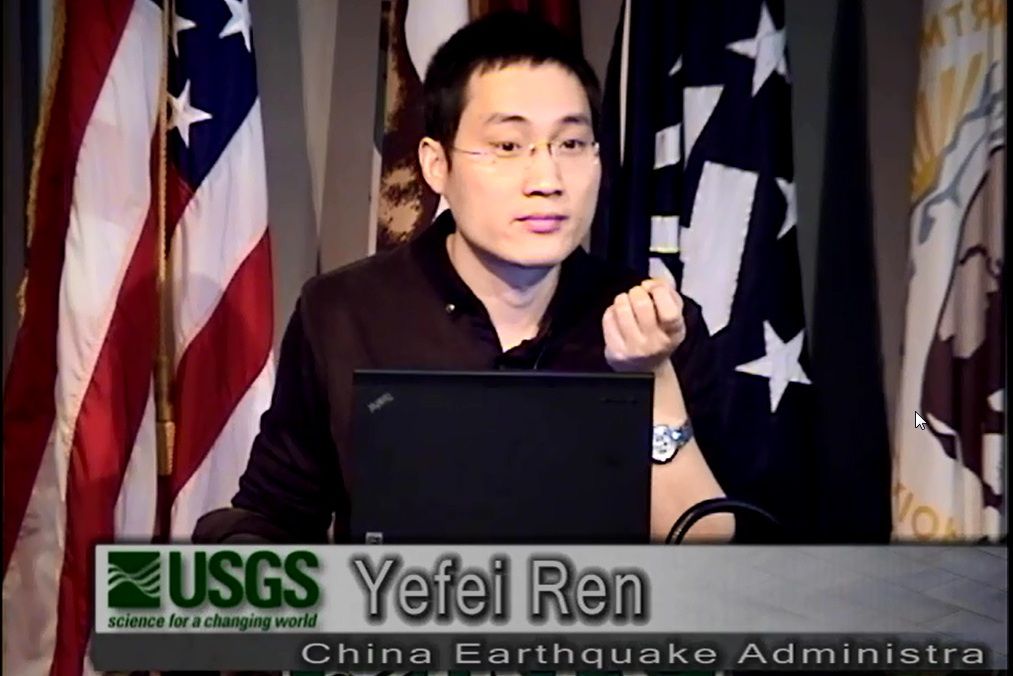研究方向
[1] 強震動觀測與套用技術、強震動記錄數據處理與分析
[2] 強震動記錄工程選取方法、地震性態危險性需求理論與方法
[3] 近場地震動特徵、地震場地效應、地震動預測與模擬
[4] 地震記錄廣義反演理論與方法、震源與路徑效應參數反演
[5] 地震海嘯危險性評估方法
學習經歷
[1] 2011.09–2014.07, 中國地震局工程力學研究所, 防災減災工程及防護工程, 博士, 導師:
溫瑞智[2] 2011.09–2012.09, 政策研究大學院大學, 防災政策, 碩士, 導師: 鹿嶋俊英、山中浩明
[3] 2005.09–2008.07, 中國地震局工程力學研究所, 防災減災工程及防護工程, 碩士, 導師: 溫瑞智
[4] 2001.09–2005.07, 江蘇大學, 土木工程, 學士
工作經歷
[1] 2020.01-, 中國地震局工程力學研究所, 地震作用與地震區劃創新團隊, 研究員
[2] 2015.12-2020.01, 中國地震局工程力學研究所, 工程地震研究室, 副研究員(破格晉升)
[3] 2012.12-2015.12, 中國地震局工程力學研究所, 工程地震研究室, 助理研究員
[4] 2011.01-2012.12, 中國地震局工程力學研究所, 工程地震研究室, 研究實習員
[5] 2009.02-2010.12, 中國地震局工程力學研究所, 國家強震動台網中心, 研究實習員
榮譽與獎勵
[1] Source Characteristics, Site Effects, and Path Attenuation from Spectral Analysis of Strong-Motion Recordings in the 2016 Kaikōura Earthquake Sequence,
李善邦青年優秀地震科技論文三等獎, 第一作者, 2019年
[2] 入選“中國地震局青年人才”隊伍, 2019年
[3] 黑龍江省“頭雁”團隊成員, 2019年
[4] 黑龍江省優秀青年基金獲得者, 2019年
[5] 中國抗震規範強震記錄選取的初選條件研究, 《防災減災工程學報》年度優秀論文“熱點論文TOP10”, 第三作者, 2019年
[6] 我國地震海嘯危險性機率分析方法, 《華南地震》期刊優秀論文, 第二作者, 2019年
[7] 強震動記錄處理方式對結構彈塑性回響影響研究, 第28屆全國結構工程學術會議優秀論文一等獎, 第四作者, 2019年
[8] 機率地震海嘯危險性分析中地震樣本容量的確定—考慮震級分布完備性, 第十屆全國地震工程學術會議優秀論文獎, 第二作者, 2018年
[9] 中國沿海核電建設場址地震海嘯危險性分析, 中國核能行業協會科學技術獎三等獎, 排名第三, 2016年
[10] 強地震動的近場效應及場地特性識別研究, 中國地震局防震減災科技成果獎三等獎, 排名第三, 2016年
[11] 2013年4月20日四川蘆山地震強地面運動三要素特徵分析, 第一屆中國科協優秀科技論文遴選計畫優秀論文(全國共90篇入選), 第一作者, 2016年
[12] 地震海嘯數值模擬中海洋水深數據的敏感性研究, 領跑者5000中國精品科技期刊頂尖學術論文, 第一作者, 2016年
[13] 蘆山地震場地非線性反應特徵分析, 第九屆全國地震工程學術會議優秀論文獎, 第三作者, 2014年
[14] 2012年度“劉恢先地震工程獎學金”(全球9人入選), 2012年
[15] Best Research Award for Distinguished Research in the Disaster Management Policy Program 2011-2012, GRIPS and BRI (日本政策研究大學院大學和建築研究所2011-2012年度日本災害管理政策項目最佳研究獎), 2012年
[16] 基於數值模擬的我國地震海嘯危險性分析研究,2009年度中國地震局優秀碩士學位論文,2009年
代表性論文
2020
[1] Peibin Xu, Yefei Ren*, Ruizhi Wen, Hongwei Wang. Observations on Regional Variability in Ground-Motion Amplitude from Six Mw ~ 6.0 Earthquakes of the North–South Seismic Zone in China. Pure and Applied Geophysics, 2020, 177(1): 247–264.
[2] Kun Ji, Ruizhi Wen, Yefei Ren, Yadab P. Dhakal. Nonlinear seismic site response classification using K-means clustering algorithm: Case study of the September 6, 2018 Mw6.6 Hokkaido Iburi-Tobu earthquake, Japan. Soil Dynamics and Earthquake Engineering, 2020, 128, paper ID: 105907.
[3] 任葉飛, 尹建華, 溫瑞智, 冀昆. 結構抗倒塌易損性分析中地震動輸入不確定性影響研究. 工程力學, 2020, 37(1): 115-125.
2019
[4] Kun Ji, Yefei Ren*, Ruizhi Wen, Chun-Hsiang Kuo. Near-field velocity pulse-like ground motions on February 6, 2018 MW6.4 Hualien, Taiwan earthquake and structural damage implications. Soil Dynamics and Earthquake Engineering, 2019, 126, paper ID: 105784.
[5] Hongwei Wang, Yefei Ren, Ruizhi Wen, Peibin Xu. Investigating the Contribution of Stress Drop to Ground-Motion Variability by Simulations Using the Stochastic Empirical Green’s Function Method. Pure and Applied Geophysics, 2019, 176(10): 4415–4430.
[6] Hongwei Wang, Yefei Ren*, Ruizhi Wen, Peibin Xu. Breakdown of Earthquake Self‐Similar Scaling and Source Rupture Directivity in the 2016–2017 Central Italy Seismic Sequence. Journal of Geophysical Research: Solid Earth, 2019, 124(4): 3898-3917.
[7] 李琳, 任葉飛, 溫瑞智, 冀昆. 用於強震動記錄選取的EPA均值目標譜的確定. 地震研究, 2019, 42(4): 584-593.
[8] 任葉飛, 謝俊舉, 李平, 溫衛平. 《強震動觀測及其工程套用》專輯序言. 地震研究, 2019, 42(4): 455-456.
[9] 宋碧野, 韓煒, 任葉飛, 溫瑞智. 強震動記錄自適應基線校正方法:汶川地震套用. 地震工程學報, 2019, 41(4): 1046-1052.
[10] 溫瑞智, 冀昆, 任葉飛. 結構時程分析中多層次強震動記錄輸入選取研究綜述. 地震工程與工程振動, 2019, 39(5): 1-18.
2018
[11] 任葉飛, 張穎楚, 冀昆, 溫瑞智, 李琳. 全國省會城市建築結構時程分析推薦地震動輸入. 建築結構, 2018, 48(S2): 284-290.
[12] 姚鑫鑫, 任葉飛*, 溫瑞智. 四川地區場地非線性反應恢復期研究. 地震工程與工程振動, 2018, 38(S1): 110-115.
[13] 劉也, 任葉飛*, 溫瑞智, 徐朝陽. 中國東南沿海海嘯危險性區域性特徵. 地震工程與工程振動, 2018, 38(S2): 137-143.
[14] 尹建華, 冀昆, 任葉飛, 溫瑞智. 條件均值譜選取記錄的結構抗倒塌易損性分析. 哈爾濱工業大學學報, 2018, 50(12): 119-124.
[15] Ruizhi Wen, Peibin Xu, Hongwei Wang and Yefei Ren. Single‐Station Standard Deviation Using Strong-Motion Data from Sichuan Region, China. Bulletin of the Seismological Society of America, 2018, 108 (4): 2237-2247.
[16] Yefei Ren, Ying Zhou, Hongwei Wang and Ruizhi Wen. Source Characteristics, Site Effects, and Path Attenuation from Spectral Analysis of Strong-Motion Recordings in the 2016 Kaikōura Earthquake Sequence. Bulletin of the Seismological Society of America, 2018, 108(3B): 1757-1773.
[17] Yefei Ren, Hongwei Wang, Peibin Xu, Yadab P. Dhakal, Ruizhi Wen, Qiang Ma and Peng Jiang. Strong‐Motion Observations of the 2017 Ms7.0 Jiuzhaigou Earthquake: Comparison with the 2013 Ms7.0 Lushan Earthquake. Seismological Research Letters, 2018, 89(4): 1354-1365.
[18] Hongwei Wang, Yefei Ren* and Ruizhi Wen. Source parameters, path attenuation and site effects from strong-motion recordings of the Wenchuan aftershocks (2008–2013) using a non-parametric generalized inversion technique. Geophysical Journal International, 2018, 212: 872–890.
[19] Kun Ji, Najib Bouaanani, Ruizhi Wen and Yefei Ren. Introduction of conditional mean spectrum and conditional spectrum in the practice of seismic safety evaluation in China. Journal of Seismology, 2018, 22(4): 1005-1024.
[20] 徐朝陽, 任葉飛, 溫瑞智, 劉也. 機率地震海嘯危險性分析中地震樣本容量的確定—考慮震級分布完備性. 地震工程與工程振動, 2018, 38(4): 117-123.
[21] Peibin Xu, Ruizhi Wen and Yefei Ren. Comparison of strong-motion records and damage implications between the 2014 Yunnan Ms6.5 Ludian earthquake and Ms6.6 Jinggu earthquake. Earthquake Science, 2018, 31(1): 12-18.
[22] 溫瑞智, 尹建華, 冀昆, 任葉飛. 結構需求機率危險性分析中強震記錄選取研究. 土木工程學報, 2018, 51(S2): 35-40+47.
2017
[23] Yefei Ren, Hongwei Wang and Ruizhi Wen. Imprint of Rupture Directivity from Ground Motions of the 24 August 2016 Mw6.2 Central Italy Earthquake. Tectonics, 2017, 36(12): 3178–3191.
[24] 王宏偉, 任葉飛*, 溫瑞智. 2017年8月8日九寨溝MS7.0地震震源譜及震中區域品質因子. 地球物理學報, 2017, 60(10): 4117-4123.
[25] 任葉飛,張鵬,溫瑞智,徐朝陽.通過WCEE跟蹤國際海嘯研究動態及我國海嘯防災減災工作的思考. 地震工程與工程振動, 2017, 37(3): 182-198.
[26] Kun Ji, Yefei Ren*, Ruizhi Wen. Site classification for National Strong Motion Observation Network System (NSMONS) stations in China using an empirical H/V spectral ratio method. Journal of Asian Earth Sciences, 2017, 147: 79–94.
[27] 冀昆, 溫瑞智, 任葉飛. 適用於我國抗震設計規範的天然強震記錄選取. 建築結構學報, 2017, 38(12): 57-67.
[28] 溫瑞智, 徐培彬, 任葉飛, 周寶峰. 強震動記錄Flatfile的研究進展. 地震工程與工程振動, 2017, 37(3): 38-47.
[29] Kun Ji, Najib Bouaanani, Ruizhi Wen, and Yefei Ren. Correlation of Spectral Accelerations for Earthquakes in China. Bulletin of the Seismological Society of America, 2017, 107(3): 1213–1226.
[30] 姚鑫鑫, 任葉飛*, 溫瑞智. 汶川地震強餘震場地非線性反應. 地震地磁觀測與研究, 2017, 37(2): 104-111.
[31] Yefei Ren, Ruizhi Wen, Xinxin Yao and Kun Ji. Five parameters for the evaluation of the soil nonlinearity during the Ms8.0 Wenchuan Earthquake using the HVSR method. Earth, Planets and Space, 2017, 69, paper no. 116, 1-17.
[32] 冀昆, 任葉飛*, 溫瑞智. 譜比法場地分類研究綜述. 世界地震工程, 2017, 33(1): 91-99.
[33] Hongwei Wang, Ruizhi Wen, and Yefei Ren. Simulating Ground-Motion Directivity Using Stochastic Empirical Green’s Function Method. Bulletin of the Seismological Society of America, 2017, 107(1): 359-371.
[34] 姜永正, 王宏偉, 任葉飛, 溫瑞智. 2016年8月24日義大利Mw6.2地震近場地震動方向 性效應. 地震學報, 2017, 39(1): 132-142.
[35] 王宏偉, 任葉飛*, 溫瑞智. 地震動震源、路徑及場地效應分析的廣義反演方法研究進展. 地球物理學進展, 2017, 32(1): 78-86.
[36] Yefei Ren, Ruizhi Wen, Peng Zhang, Zhibo Yang, Rong Pan and Xiaojun Li. Implications of Local Sources to Probabilistic Tsunami Hazard Analysis in South Chinese Coastal Area. Journal of Earthquake and Tsunami, 2017, 11(1): 1740001, 1-26.
學術兼職
[1] Member of IAEE/COSMOS International Strong Motion Committee (ISMC)
[2] 聯合國教科文組織政府間海洋學委員會(UNESCO/IOC)海洋學專家庫成員
[3] 中國地震局工程力學研究所科學技術委員會委員
[4] 中國地震學會會員
[5] 中國地震學會近岸與離岸工程災害環境防護專業委員會委員
[6] 中國地震學會強震動觀測技術與套用專業委員會青年工作委員會委員
[7] 《世界地震工程》編委
[8] 《地震研究》特邀科學編輯

